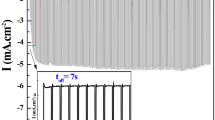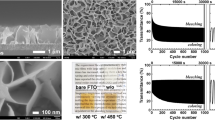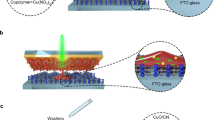Abstract
Herein, a facile pulse electrodeposition procedure with a 1 s off-time between pulses is reported for a successful fabrication of porous nickel oxide (NiO) films on an indium tin oxide substrate. Large transmittance modulation of 39.2% at 550 nm, fast switching speed (coloring and bleaching of 5.2 s and 2.3 s), high coloration efficiency of 20.01 cm2 C−1, and long-term stability over 750 cycles were achieved. In comparison to the NiO films synthesized by continuous electrodeposition, the porous morphology of the NiO fabricated by pulsed electrodeposition facilitates charge transfer and electrolyte infiltration, as well as reduces the expansion/shrinkage of the NiO lattice during OH− insertion/extraction, resulting in an outstanding electrochromic performance. These results show that pulsed electrodeposition is a promising method for manufacturing NiO films with enhanced EC performance.
Graphical abstract






Similar content being viewed by others
Change history
15 July 2023
This article has been retracted. Please see the Retraction Notice for more detail: https://doi.org/10.1007/s10800-023-01952-6
References
Wang X, Liu B, Tang J et al (2019) Preparation of Ni(OH)2/TiO2 porous film with novel structure and electrochromic property. Sol Energy Mater Sol Cells 191:108–116
Liu Q, Dong G, Xiao Y et al (2015) An all-thin-film inorganic electrochromic device monolithically fabricated on flexible PET/ITO substrate by magnetron sputtering. Mater Lett 142:232–234
Shen DE, Österholm AM, Reynolds JR (2015) Out of sight but not out of mind: the role of counter electrodes in polymer-based solid-state electrochromic devices. J Mater Chem C 3:9715–9725
Choi D, Lee M, Kim H et al (2018) Investigation of dry-deposited ion storage layers using various oxide particles to enhance electrochromic performance. Sol Energy Mater Sol Cells 174:599–606
Zhou K, Wang H, Zhang Y et al (2016) An advanced technique to evaluate the electrochromic performances of NiO films by multi-cycle double-step potential chronocoulometry. J Electrochem Soc 163:H1033–H1040
Wang C, Dong G, Zhao Y et al (2020) Enhanced electrochromic performance on anodic nickel oxide inorganic device via lithium and aluminum co-doping. J Alloys Compd 821:153365
Cao F, Pan GX, Xia XH et al (2013) Hydrothermal-synthesized mesoporous nickel oxide nanowall arrays with enhanced electrochromic application. Electrochim Acta 111:86–91
Velevska J, Ristova M (2002) Electrochromic properties of NiOx prepared by low vacuum evaporation. Sol Energy Mater Sol Cells 73:131–139
Liao C-C (2012) Lithium-driven electrochromic properties of electrodeposited nickel hydroxide electrodes. Sol Energy Mater Sol Cells 99:26–30
Uplane MM, Mujawar SH, Inamdar AI et al (2007) Structural, optical and electrochromic properties of nickel oxide thin films grown from electrodeposited nickel sulphide. Appl Surf Sci 253:9365–9371
Sonavane AC, Inamdar AI, Shinde PS et al (2010) Efficient electrochromic nickel oxide thin films by electrodeposition. J Alloys Compd 489:667–673
Dalavi DS, Devan RS, Patil RS et al (2013) Electrochromic performance of sol–gel deposited NiO thin film. Mater Lett 90:60–63
Tenent RC, Gillaspie DT, Miedaner A et al (2010) Fast-switching electrochromic Li + -doped NiO films by ultrasonic spray deposition. J Electrochem Soc 157:H318–H322
Zhang E, Tang Y, Zhang Y et al (2009) Hydrothermal synthesis of β-nickel hydroxide nanocrystalline thin film and growth of oriented carbon nanofibers. Mater Res Bull 44:1765–1770
Inamdar AI, Sonavane AC, Pawar SM et al (2011) Electrochromic and electrochemical properties of amorphous porous nickel hydroxide thin films. Appl Surf Sci 257:9606–9611
Pagnanelli F, Altimari P, Bellagamba M et al (2015) Pulsed electrodeposition of cobalt nanoparticles on copper: influence of the operating parameters on size distribution and morphology. Electrochim Acta 155:228–235
Su C, Qiu M, An Y et al (2020) Controllable fabrication of α-Ni(OH)2 thin films with preheating treatment for long-term stable electrochromic and energy storage applications. J Mater Chem C 8:3010–3016
Cai G, Tu J, Gu C et al (2013) One-step fabrication of nanostructured NiO films from deep eutectic solvent with enhanced electrochromic performance. J Mater Chem A 1:4286–4292
Li Q, Feng Z, Zhang J et al (2014) Pulse reverse electrodeposition and characterization of nanocrystalline zinc coatings. RSC Adv 4:52562–52570
Li Q, Feng Z, Liu L et al (2015) Research on the tribological behavior of a nanocrystalline zinc coating prepared by pulse reverse electrodeposition. RSC Adv 5:12025–12033
Di Girolamo D, Matteocci F, Piccinni M et al (2020) Anodically electrodeposited NiO nanoflakes as hole selective contact in efficient air processed p-i-n perovskite solar cells. Sol Energy Mater Sol Cells 205:110288
Rodzi SZF, Mohd Y (2012) The influence of deposition temperature on the electrodeposition of NiO films on ITO-glass substrate. In: 2012 IEEE symposium on humanities, science and engineering research, pp 531–535
Quy VHV, Jo I-R, Kang S-H, Ahn K-S (2021) Amorphous-crystalline dual phase WO3 synthesized by pulsed-voltage electrodeposition and its application to electrochromic devices. J Ind Eng Chem 94:264–271
Park SH, Shin HS, Kim YH et al (2013) Template-free and filamentary growth of silver nanowires: application to anisotropic conductive transparent flexible electrodes. Nanoscale 5:1864–1869
Cai G, Cui M, Kumar V et al (2016) Ultra-large optical modulation of electrochromic porous WO3 film and the local monitoring of redox activity. Chem Sci 7:1373–1382
Vijayakumar E, Yun Y-H, Quy VHV et al (2019) Development of tungsten trioxide using pulse and continuous electrodeposition and its properties in electrochromic devices. J Electrochem Soc 166:D86–D92
Zolotukhina EV, Bezverkhyy IS, Vorotyntsev MA (2014) One-stage periodical anodic-cathodic double pulse deposition of nanocomposite materials. application to Prussian Blue/polypyrrole film coated electrodes. Electrochim Acta 122:247–258
Mateos D, Valdez B, Castillo JR et al (2019) Synthesis of high purity nickel oxide by a modified sol-gel method. Ceram Int 45:11403–11407
Yuan X-C, Tang J-L, Zeng H-Z, Wei X-H (2014) Abnormal coexistence of unipolar, bipolar, and threshold resistive switching in an Al/NiO/ITO structure. Nanoscale Res Lett 9:268
Tian Y, Li Z, Dou S et al (2018) Facile preparation of aligned NiO nanotube arrays for electrochromic application. Surf Coat Technol 337:63–67
Xi Q, Gao G, Zhou H et al (2019) Highly efficient inverted perovskite solar cells mediated by electrodeposition-processed NiO NPs hole-selective contact with different energy structure and surface property. Appl Surf Sci 463:1107–1116
Dalavi DS, Devan RS, Patil RS et al (2012) Electrochromic properties of dandelion flower like nickel oxide thin films. J Mater Chem A 1:1035–1039
Koshtyal Y, Nazarov D, Ezhov I et al (2019) Atomic layer deposition of NiO to produce active material for thin-film lithium-ion batteries. Coatings 9:301
Liu A, Liu G, Zhu H et al (2016) Hole mobility modulation of solution-processed nickel oxide thin-film transistor based on high-k dielectric. Appl Phys Lett 108:233506
Diao C-C, Huang C-Y, Yang C-F, Wu C-C (2020) Morphological, optical, and electrical properties of P-type nickel oxide thin films by nonvacuum deposition. Nanomaterials 10:636
Liang H, Li R, Li C et al (2019) Regulation of carbon content in MOF-derived hierarchical-porous NiO@C films for high-performance electrochromism. Mater Horiz 6:571–579
Abe Y, Suzuki T, Kawamura M et al (2012) Electrochromic properties of NiOOH thin films prepared by reactive sputtering in an H2O atmosphere in various aqueous electrolytes. Sol Energy Mater Sol Cells 99:38–42
Zhang J, Cai G, Zhou D et al (2014) Co-doped NiO nanoflake array films with enhanced electrochromic properties. J Mater Chem C 2:7013–7021
Guo Q, Zhao X, Li Z et al (2020) A novel solid-state electrochromic supercapacitor with high energy storage capacity and cycle stability based on poly(5-formylindole)/WO3 honeycombed porous nanocomposites. Chem Eng J 384:123370
Liu Q, Dong G, Xiao Y et al (2016) Electrolytes-relevant cyclic durability of nickel oxide thin films as an ion-storage layer in an all-solid-state complementary electrochromic device. Sol Energy Mater Sol Cells 157:844–852
Ren Y, Chim WK, Guo L et al (2013) The coloration and degradation mechanisms of electrochromic nickel oxide. Sol Energy Mater Sol Cells 116:83–88
Cai G, Wang X, Zhou D et al (2013) Hierarchical structure Ti-doped WO3 film with improved electrochromism in visible-infrared region. RSC Adv 3:6896–6905
Pham NS, Seo YH, Park E et al (2020) Implementation of high-performance electrochromic device based on all-solution-fabricated Prussian blue and tungsten trioxide thin film. Electrochim Acta 353:136446
Pham NS, Seo YH, Park E et al (2020) Data on characterization and electrochemical analysis of zinc oxide and tungsten trioxide as counter electrodes for electrochromic devices. Data Brief 31:105891
Le VX, Lee H, Pham NS et al (2021) Stainless steel 304 needle electrode for precise glucose biosensor with high signal-to-noise ratio. Sens Actuators B 346:130552
Zhang B, Xu C, Xu G et al (2019) Amorphous titanium dioxide film with improved electrochromism in near-infrared region. Opt Mater 89:191–196
Zhao Y, Zhang X, Chen X et al (2020) Preparation of WO3 films with controllable crystallinity for improved near-infrared electrochromic performances. ACS Sustain Chem Eng 8:11658–11666
Chen Y, Bi Z, Li X et al (2017) High-coloration efficiency electrochromic device based on novel porous TiO2@Prussian blue core-shell nanostructures. Electrochim Acta 224:534–540
Bouessay I, Rougier A, Poizot P et al (2005) Electrochromic degradation in nickel oxide thin film: a self-discharge and dissolution phenomenon. Electrochim Acta 50:3737–3745
Azens A, Kullman L, Vaivars G et al (1998) Sputter-deposited nickel oxide for electrochromic applications. Solid State Ion 113–115:449–456
Green SV, Watanabe M, Oka N et al (2012) Electrochromic properties of nickel oxide based thin films sputter deposited in the presence of water vapor. Thin Solid Films 520:3839–3842
Liu L, Yu Y, Yan C et al (2015) Wearable energy-dense and power-dense supercapacitor yarns enabled by scalable graphene–metallic textile composite electrodes. Nat Commun 6:7260
Author information
Authors and Affiliations
Contributions
The manuscript was written through contributions of all authors. All authors have given approval to the final version of the manuscript.
Corresponding authors
Ethics declarations
Conflict of interest
The authors declare no competing financial interest.
Additional information
Publisher's Note
Springer Nature remains neutral with regard to jurisdictional claims in published maps and institutional affiliations.
This article has been retracted. Please see the retraction notice for more detail: https://doi.org/10.1007/s10800-023-01952-6"
Supplementary Information
Below is the link to the electronic supplementary material.
Rights and permissions
Springer Nature or its licensor (e.g. a society or other partner) holds exclusive rights to this article under a publishing agreement with the author(s) or other rightsholder(s); author self-archiving of the accepted manuscript version of this article is solely governed by the terms of such publishing agreement and applicable law.
About this article
Cite this article
Pham, N.S., Phan, P.T.Q. & Le, V.X. RETRACTED ARTICLE: Porous NiO via pulsed electrodeposition towards enhanced electrochromic properties. J Appl Electrochem 52, 1343–1351 (2022). https://doi.org/10.1007/s10800-022-01716-8
Received:
Accepted:
Published:
Issue Date:
DOI: https://doi.org/10.1007/s10800-022-01716-8




